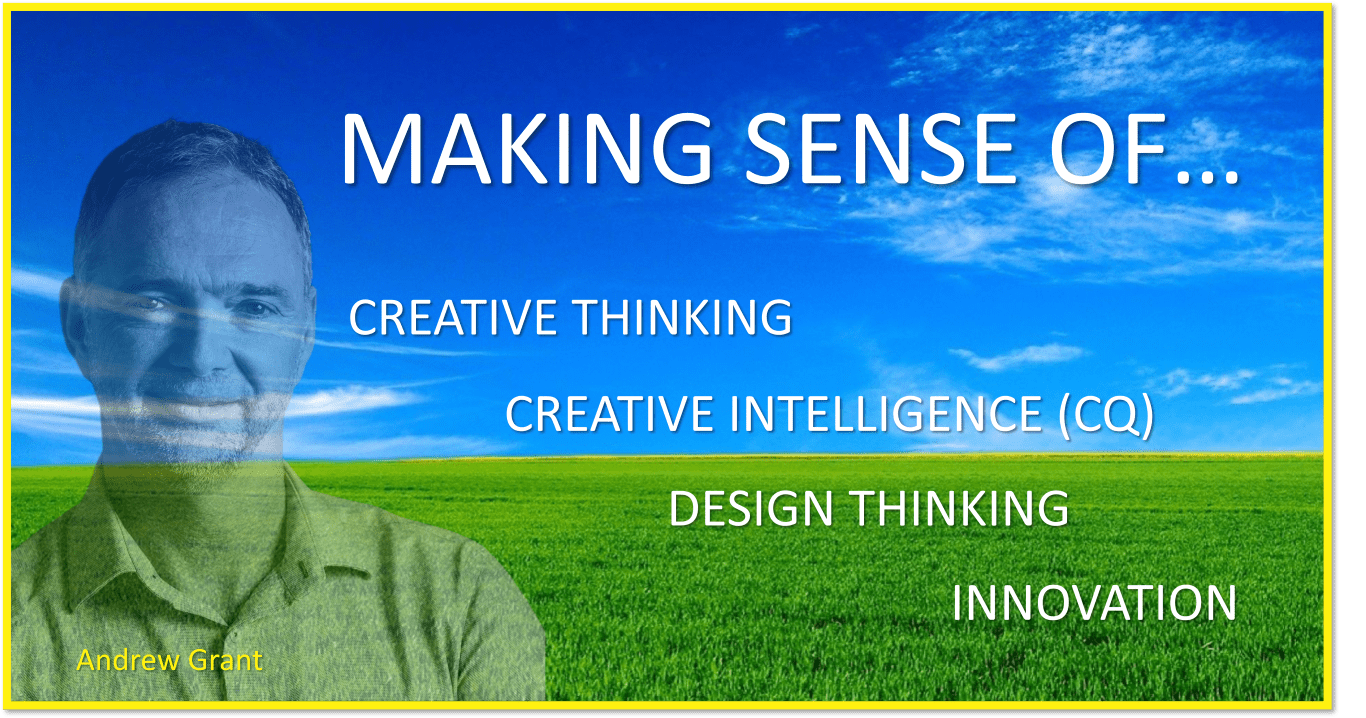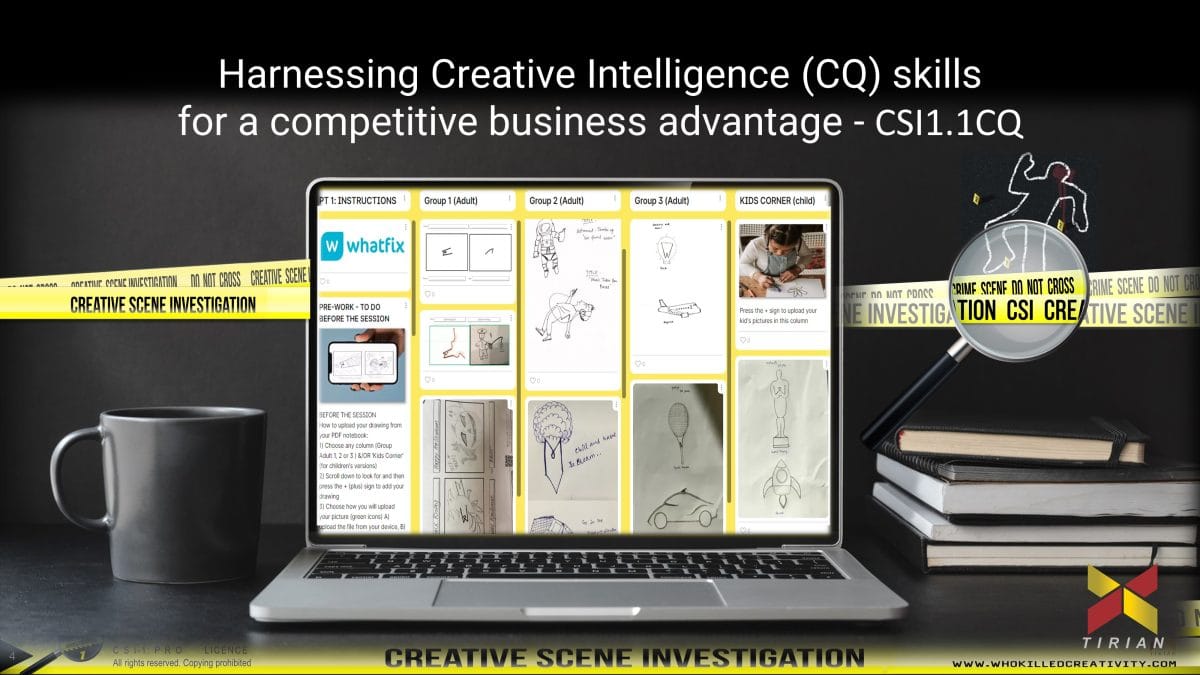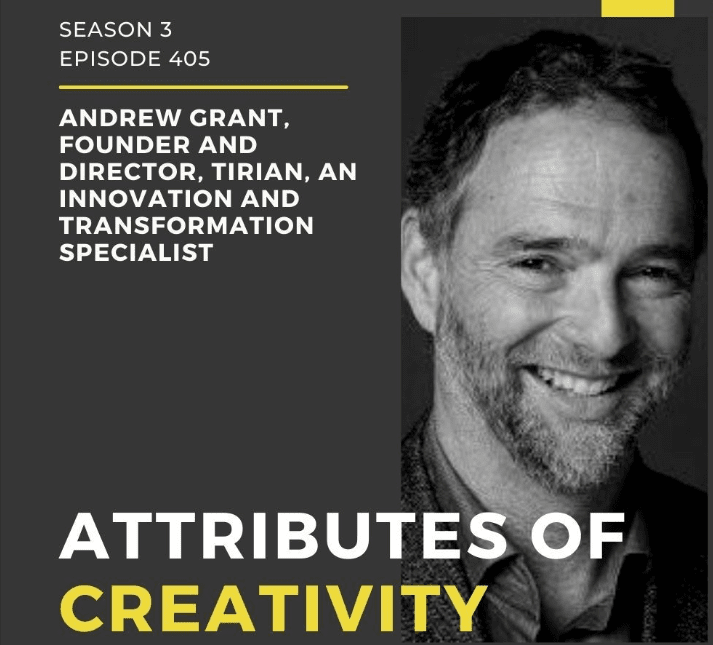What is Creativity? And can Creative Thinking be measured? by Andrew Grant
Most people overuse innovation buzz words and follow the trends. Once upon a time it was popular to talk about the importance of being “creative”, but now “innovation” has taken its place.
So many of us want to jump straight to the solution (the innovation outcome), but if they miss the process of creativity it’s unlikely they’ll get a great result. Innovation is typically described as the application of ideas that are both original and practical, yet those original ideas need to be generated first.
What is CQ- Creative Intelligence?
Creativity can best be measured by the 7 Torrance Test of Creative Thinking (TTCT) attributes, including the core abilities to think both divergently and convergently for critical thinking and analysis. This is a great measure of Creative Intelligence (CQ).The Creative Intelligence attributes include the fundamental skills needed in order to be creative, and TTCT is the gold standard to measure CQ. The approach was built on J.P. Guilford’s work and created by Ellis Paul Torrance.
So how creative do you think you are in your thinking? Usually based on a series of discrete tasks administered by a psychologist, the Torrance Test is not a perfect measure of creativity and it does not indicate future creative potential, but it has proven remarkably accurate in predicting creative accomplishments.
The TTCT originally involved simple tests of divergent thinking and other problem-solving skills, which were scored on four scales. We have converted these to 7 attributes by adapting the non-verbal visual test, and then we map these attributes to design thinking processes.
What is Design Thinking? – and how can it enable innovation?
Design Thinking (DT) has become a popular model to describe the non-linear, iterative creative and human-centric process that designers typically use to understand the end users, challenge assumptions, redefine problems and come up with innovative solutions to challenging problems.
Design Thinking is a method used to solve what are known as ‘Wicked Problems”. These wicked problems are identified as ‘wicked’ in the sense that they are ill-defined or tricky. For ill-defined problems, both the problem and the solution are unknown at the outset of the problem-solving exercise. ‘Wicked problems’ are opposed to “tame” or “well-defined” problems where the problem is clear, and the solution is available through some technical knowledge. This methodology is a solution-based ‘abductive’ approach used in creative thinking problem solving (CPS).
Design Thinking buzzwords can include human centred research tools (such as ‘Empathy Maps’, ‘Empathy Interviews’ etc), tools for generating creative ideas (such as ‘Ideation’ and ‘Brainstorming’) and tools for testing these ideas (such as ‘Prototyping’ and ‘Minimum Viable Product’). The way the Design Thinking process can be applied in action can be through being ‘Agile’, or through ‘Scrums’ and ‘Design Sprints’.
How are creativity and design thinking two different concepts?
CREATIVE THINKING: The thinking we do when we generate ideas. It can challenge dogma and construct unusual elements using Divergent Thinking. This can enable the ability to generate novel and useful ideas, and provide the critical ideal starter conditions for innovation. Ideas are fashioned like shapes out of clay and continually formed, destroyed and reformed through the process of experimentation. (NOTE: whenever we are refereeing to “Creativity” in this article, we are not focussing on “artist skills & talent”)
CRITICAL THINKING: The thinking we do when we judge ideas. Can apply meaning and relevance. / Convergent Thinking. Once a specific unique form takes shape that is deemed to be potentially workable, it can then be tested, developed, matured and applied at scale through more rigorous critical processes.
DESIGN THINKING: uses a set of tools and processes to solve the wicked problems.
INNOVATION: Once the creative / critical thinking /design thinking process has happened, Ideas can then grow into robust practical innovations of value.
What is innovation?
Innovation is typically described as the application of ideas that are both original and practical. Innovation is a much more nebulous concept – more of an amorphous shape-shifting energy that is initiated and fuelled by a desire for improvement. Creative and critical thinking, which can enable the ability to generate novel and useful ideas, provide the critical ideal starter conditions for innovation. The creative part is where the process can get messy and unpredictable. Ideas are fashioned like shapes out of clay and continually formed, destroyed and reformed through the process of experimentation. Once a specific unique form takes shape that is deemed to be potentially workable, it can then be tested, developed, matured and applied at scale through more rigorous critical processes. Ideas can then grow into robust practical innovations of value.
‘Innovation is finding new ways to apply energy to create improbable things, and see them catch on. It means much more than invention (creativity), because the word implies developing an invention to the point where it catches on because it is sufficiently practical, affordable, reliable and ubiquitous to be worth using.’ (Ridley)
Is it possible to build a creative culture? – and how can this impact innovation outcomes?
Culture is the glue, the unspoken range of values that dictate how we behave – whether it’s as a work team, company, city, or country, there are typically expected values and behavioural norms.
Sociologist Richard Florida has identified what he refers to as a ‘creative class’ of employees, revealing what their core values are and mapping what they are most likely to be attracted to in an organisation.
We’ve seen too many companies try to instigate a Design Thinking process and spend millions on innovation labs (or fancy offices) only to tell us they don’t work in practice. This is often because a creative culture has not been consciously established and managed.
Teaching creative thinking skills and design thinking strategies is an important first step to building an innovative culture that will support innovation. Noting that a tool (Design Thinking) is only as good as the person using it.
What is the impact of creative thinking on organisations and their employees? and why should organisations consider all the stages of creative thinking (not just jump to design thinking)?
Today’s complex rapid change world requires creative thinking skills and strategies for adapting to change through agility. It is possible to train these skills and rewire the brain to trigger more spontaneous creative insights.
Only once individual mindsets and cultural norms can be changed, is it then possible for creativity and the tools of design thinking to naturally flourish.
There are no shortcuts. Many people in companies want to jump straight to the solution or final innovation and skip the creative and critical thinking stages. But then they inevitably come up with mediocre results, or leadership blockages paralyzing any outcomes.
If its now a given that all companies need to innovate or die, then then the question is who does it best, and how do organisations: attract the right people and look after them?
- To innovate one needs a process (Design Thinking).
- HOWEVER – to be effective at Design Thinking, one needs to first have a creative mindset. (CQ)
- HOWEVER – To have a creative mindset, one needs to develop the CQ skills, and to do this one needs to first diagnose their personal position and cultural environment.
The Creative Class of people is the most sought-after in companies, as they add the most value. Creative classes are responsible for economic growth, stable democratic development, and positively valued political aspects. The war for talent shows that creative people attract creative people (and the opposite is also true). The places that attract and retain this talent will win this race.
Conclusion:
The tools of Design Thinking, Agile, and implementation of Innovation are only as good as the people using them and the culture they work in.
Consider: Have you and your company built a strong foundation established not on simple buzzwords but on a conscious innovation strategy?
Our Creativity Suite covers the full range of programs from introducing the topic, diagnosing, teach and learn, try and apply, through to using design thinking,
We have mapped 7 CQ (Creative Quotient- TTCT) skills needed for effective design thinking. MORE
CSI- ‘Who Killed Creativity?’ is a diagnostic tool to help leaders, teams and organisation learn about how to attract, develop, retain talent to use creative (and critical) thinking for better results faster.
In The Brand Called You podcast (S3 E405), Innovation and Transformation specialist Andrew Grant talks about creativity, CQ – Creative Intelligence and how to measure it.




